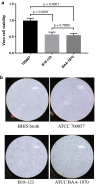Hypervirulent clade 2, ribotype 019/sequence type 67 Clostridioides difficile strain from Japan
- PMID: 31700548
- PMCID: PMC6827173
- DOI: 10.1186/s13099-019-0336-3
Hypervirulent clade 2, ribotype 019/sequence type 67 Clostridioides difficile strain from Japan
Abstract
Background: Clostridioides difficile ribotype (RT) 019/sequence type (ST) 67 strains belong to a hypervirulent lineage closely related to RT027/ST1; however, limited data are available for hypervirulent clade 2 lineages in Japan. Herein, we report the draft genome of a C. difficile strain B18-123 belonging to clade 2, RT019/ST67 for the first time in Japan.
Results: The pathogenicity locus carried by B18-123 (19.6 kb) showed higher homology (97.29% nucleotide identity) with strain R20291 (RT027/ST1) than the reference strain 630 (RT012/ST54), and B18-123 harbored 8-nucleotide substitutions in tcdC. However, it did not contain an 18-base pair (bp) deletion or a single-bp deletion at position 117 in tcdC, which was identified in the previous strain R20291. A cytotoxicity assay revealed similar cytotoxicity levels between strains B18-123 and ATCC BAA-1870 (RT027/ST1). The B18-123 strain was found to be susceptible to metronidazole and vancomycin.
Conclusion: Our findings contribute to the further understanding of the characteristics of hypervirulent clade 2 including RT019/ST67 lineages.
Keywords: Binary toxin; Cdt locus; Clostridioides difficile; Hypervirulent clade 2; Pathogenicity locus; Ribotype 019; Sequence type 67; Toxin A; Toxin B.
© The Author(s) 2019.
Conflict of interest statement
Competing interestsThe authors declare that they have no competing interests.
Figures


Similar articles
-
Characterization of the virulence of a non-RT027, non-RT078 and binary toxin-positive Clostridium difficile strain associated with severe diarrhea.Emerg Microbes Infect. 2018 Dec 12;7(1):211. doi: 10.1038/s41426-018-0211-1. Emerg Microbes Infect. 2018. PMID: 30542069 Free PMC article.
-
Emergence of a ribotype 244 strain of Clostridium difficile associated with severe disease and related to the epidemic ribotype 027 strain.Clin Infect Dis. 2014 Jun;58(12):1723-30. doi: 10.1093/cid/ciu203. Epub 2014 Apr 4. Clin Infect Dis. 2014. PMID: 24704722
-
Phenotypic characterisation of Clostridium difficile PCR ribotype 251, an emerging multi-locus sequence type clade 2 strain in Australia.Anaerobe. 2019 Dec;60:102066. doi: 10.1016/j.anaerobe.2019.06.019. Epub 2019 Jun 28. Anaerobe. 2019. PMID: 31260740
-
Characterization of the virulence of three novel clade 2 Clostridioides (Clostridium) difficile strains and a two-year screening in animals and humans in Brazil.PLoS One. 2022 Aug 26;17(8):e0273013. doi: 10.1371/journal.pone.0273013. eCollection 2022. PLoS One. 2022. PMID: 36026500 Free PMC article.
-
The largely unnoticed spread of Clostridioides difficile PCR ribotype 027 in Germany after 2010.Infect Prev Pract. 2020 Nov 3;2(4):100102. doi: 10.1016/j.infpip.2020.100102. eCollection 2020 Dec. Infect Prev Pract. 2020. PMID: 34368730 Free PMC article. Review.
Cited by
-
A case of community-acquired Clostridioides difficile infection causing intussusception, severe pneumonia, and severe hypokalemia.BMC Infect Dis. 2024 Jul 29;24(1):744. doi: 10.1186/s12879-024-09660-y. BMC Infect Dis. 2024. PMID: 39069609 Free PMC article.
-
In vivo animal models confirm an increased virulence potential and pathogenicity of the NAP1/RT027/ST01 genotype within the Clostridium difficile MLST Clade 2.Gut Pathog. 2020 Sep 22;12:45. doi: 10.1186/s13099-020-00383-4. eCollection 2020. Gut Pathog. 2020. PMID: 32983262 Free PMC article.
-
Draft Genome Sequence of a Clostridioides difficile Sequence Type 97 Strain Belonging to Hypervirulent Clade 2.Microbiol Resour Announc. 2020 Apr 2;9(14):e00245-20. doi: 10.1128/MRA.00245-20. Microbiol Resour Announc. 2020. PMID: 32241860 Free PMC article.
-
Antibiotic Resistance and Biofilm Production Capacity in Clostridioides difficile.Front Cell Infect Microbiol. 2021 Aug 4;11:683464. doi: 10.3389/fcimb.2021.683464. eCollection 2021. Front Cell Infect Microbiol. 2021. PMID: 34422678 Free PMC article.
-
Diversity of binary toxin positive Clostridioides difficile in Korea.Sci Rep. 2023 Jan 11;13(1):576. doi: 10.1038/s41598-023-27768-0. Sci Rep. 2023. PMID: 36631661 Free PMC article.
References
LinkOut - more resources
Full Text Sources
Molecular Biology Databases

